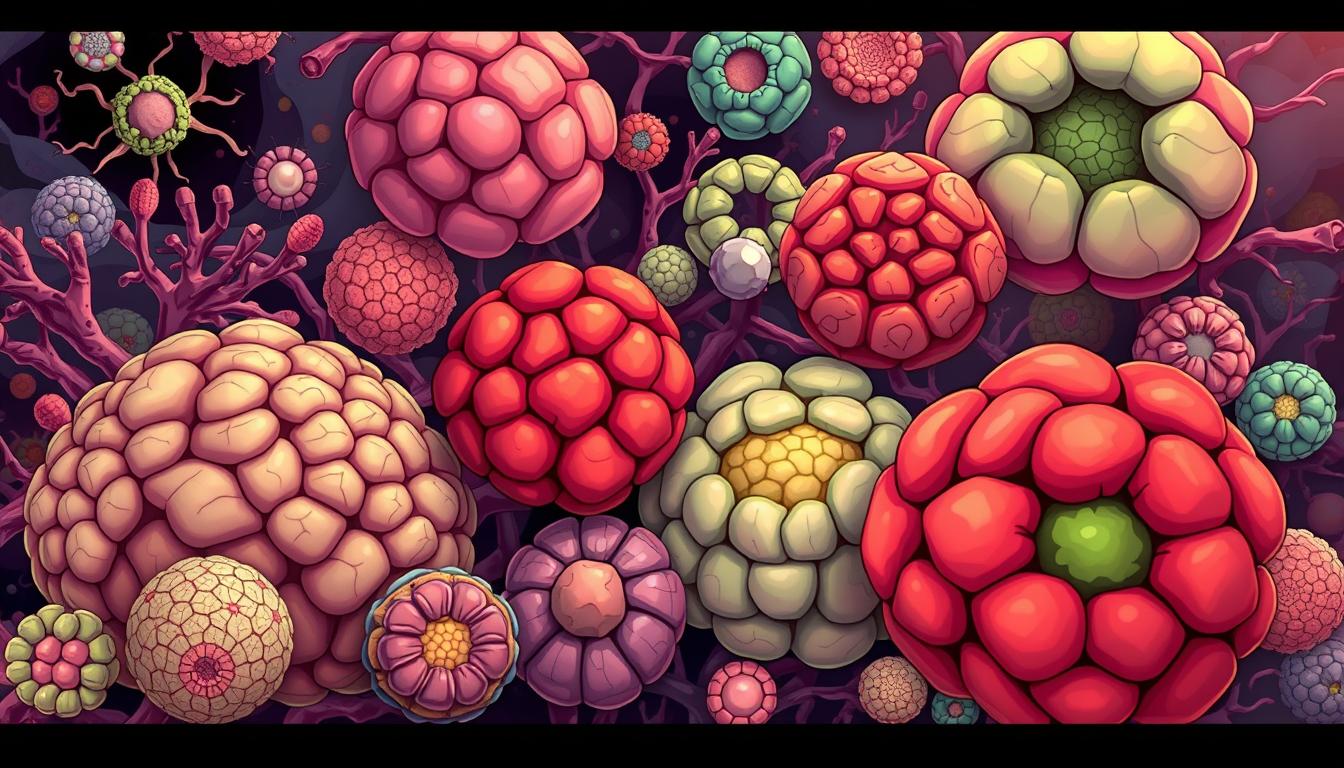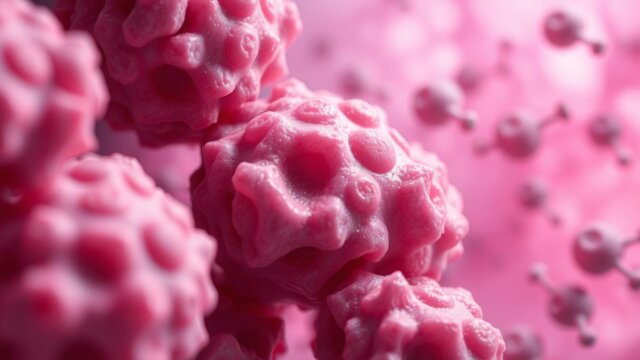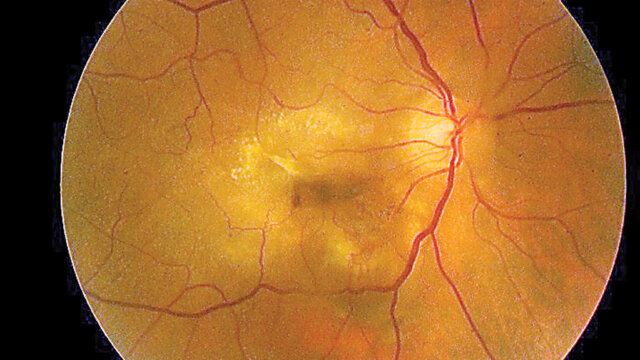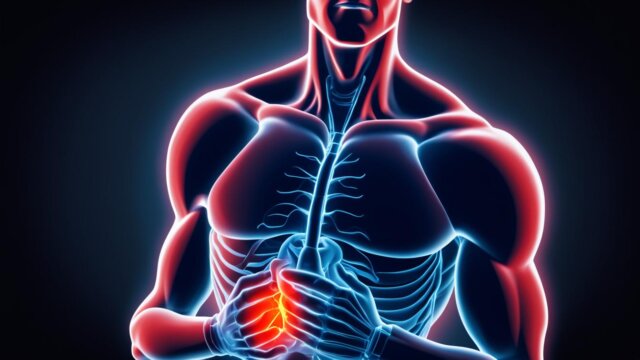FTC disclaimer: This post may contains affiliate links and we will be compensated if you click on a link and make a purchase.
Neoplasms, or tumors, are a big problem worldwide, with cancer being the second-leading cause of death. But, the field of oncology is changing fast. New ways to screen, treat, and prevent cancer are helping more people live longer. This article will explain what neoplasms are, why they happen, and how to treat them. It aims to give you the info you need to understand this important topic.
Key Takeaways
- Neoplasms can be either benign (non-cancerous) or malignant (cancerous), with malignant tumors posing a risk of metastasis or spreading to other tissues.
- Genetic factors, age, hormones, lifestyle choices, and environmental exposures can all contribute to the development of neoplastic diseases.
- Symptoms of neoplastic diseases vary depending on the location and type of tumor, but may include anemia, breathing difficulties, and skin changes.
- Diagnostic tests for neoplasms can include medical history review, biopsies, imaging scans, and endoscopy.
- Treatment options for neoplasms can range from monitoring and surgery to chemotherapy, radiation, and immunotherapy, with early diagnosis being crucial for the best outcomes.
What is a Neoplasm?
Definition and Types
A neoplasm is an abnormal growth of cells that forms a mass of tissue, also known as a tumor. These growths can be either benign (noncancerous) or malignant (cancerous). Benign tumors grow slowly and don’t spread. Malignant tumors grow fast and can spread to other tissues and organs.
Neoplasms are divided into four main groups by the ICD-10 system: benign, in situ, malignant, and uncertain or unknown. Benign neoplasms, like uterine fibroids, are not harmful. Malignant neoplasms, or cancer, can destroy tissue and spread, and can be fatal if not treated.
The term “tumor” is often confused with “neoplasm,” but they’re not the same as cancer. A tumor can be benign, precancerous, or malignant. Its growth depends on a single group of abnormal cells.
DNA damage is the main cause of malignant neoplasms. This damage can come from many sources, like tobacco smoke, UV light, and infections.
Causes of Neoplastic Disease
The exact reasons for tumor growth are still being studied. But, most cancers start with genetic mutations in cells. These changes can come from many sources, like genes we’re born with, age, hormones, the environment, and our lifestyle.
Genetics is a big part of why some people get cancer. Studies show 5-10% of cancers are caused by genes we inherit. Some genetic disorders, like Li-Fraumeni and Lynch syndromes, also raise cancer risks.
Things around us, like harmful substances and viruses, can also lead to cancer. Smoking, drinking too much alcohol, and too much sun can increase the risk of lung, liver, and skin cancers.
Hormonal imbalances, especially in the endocrine system, can cause some cancers. For example, too much estrogen can lead to breast and uterine cancers.
In short, many things can cause neoplastic diseases. There’s a mix of genetics, environment, and lifestyle. Knowing these causes helps us find ways to prevent and treat cancer and other diseases.
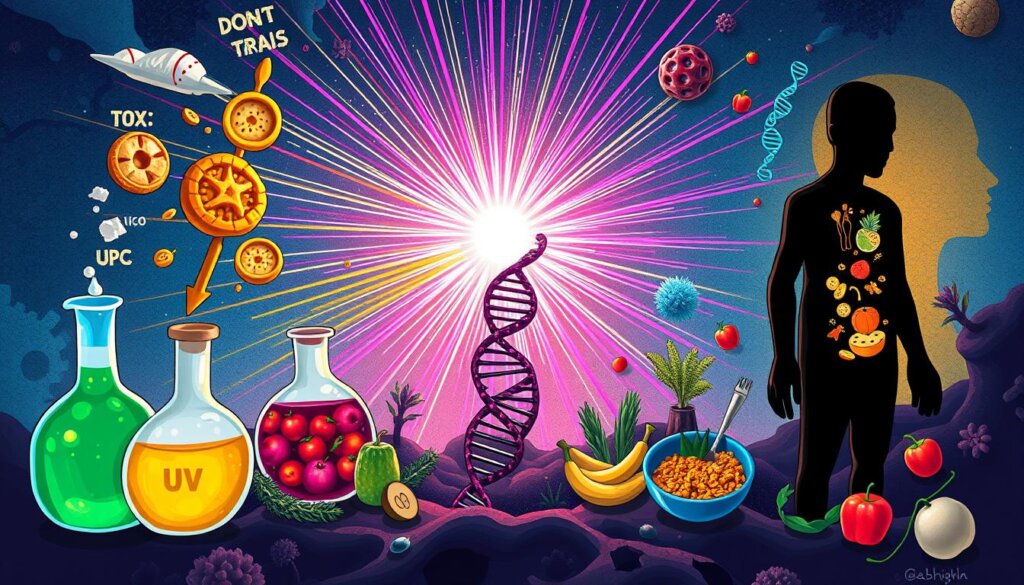
Symptoms of Neoplastic Disease
Neoplasms, or tumors, can show many symptoms. This depends on where and what type they are. Symptoms include anemia, shortness of breath, and abdominal pain. Other signs are persistent fatigue, loss of appetite, and chills.
Some tumors may not show symptoms at all.
The symptoms of a neoplasm can vary a lot. For example, breast tumors might cause tenderness and swelling. Lymph node tumors can cause swelling and weight loss. Skin tumors may appear as lesions or rashes.
These symptoms can greatly affect a person’s health. Early detection is key, as many cancers are treatable if caught early. Regular check-ups can help spot any growths that need attention.
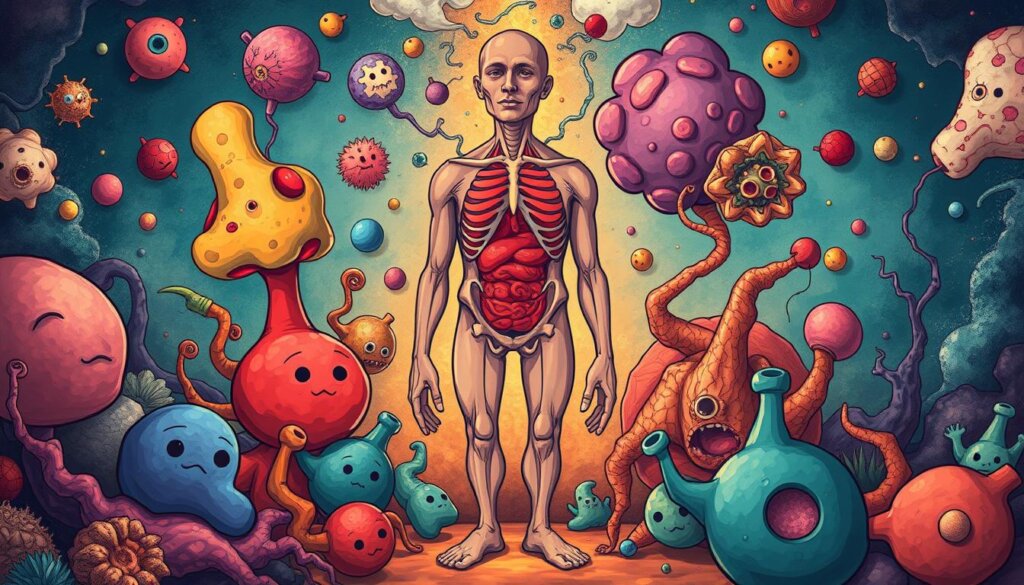
Not all tumors are cancerous. Benign tumors are usually not harmful and may only need watching. Malignant tumors, however, can spread and need aggressive treatment. Knowing the difference is important for treatment.
Symptom | Description |
|---|---|
Anemia | A decrease in the number of red blood cells or hemoglobin leads to fatigue and weakness. |
Shortness of Breath | Difficulty breathing, especially during physical activity, due to the tumor’s impact on the respiratory system. |
Abdominal Pain | Discomfort or pain in the abdomen may be caused by the location or growth of the tumor. |
Persistent Fatigue | Chronic tiredness and lack of energy can be a common symptom of many neoplastic diseases. |
Loss of Appetite | Decreased desire to eat, which may be a result of the tumor’s impact on the digestive system or overall well-being. |
Breast Neoplasm Symptoms
Breast cancer is the second most common cancer in women in the United States. A new lump or thickening in or near the breast is the most common symptom. It’s important to check any breast changes with a healthcare professional.
Signs of Breast Cancer
Other signs include tenderness, pain, swelling, redness, and irritation. You might also notice changes in breast size or shape. Nipple discharge other than breast milk and nipple changes are also signs.
Inflammatory breast cancer makes the breast look red and swollen. While rare, breast cancer can affect men too.
Ductal carcinoma is the most common type, starting in milk ducts. Lobular carcinoma starts in milk-producing lobules and is often found in both breasts.
Early detection is crucial for successful treatment. Regular self-exams and mammograms help find changes. If you notice symptoms, see your healthcare provider for evaluation and testing. Early diagnosis and treatment are key in fighting breast cancer.
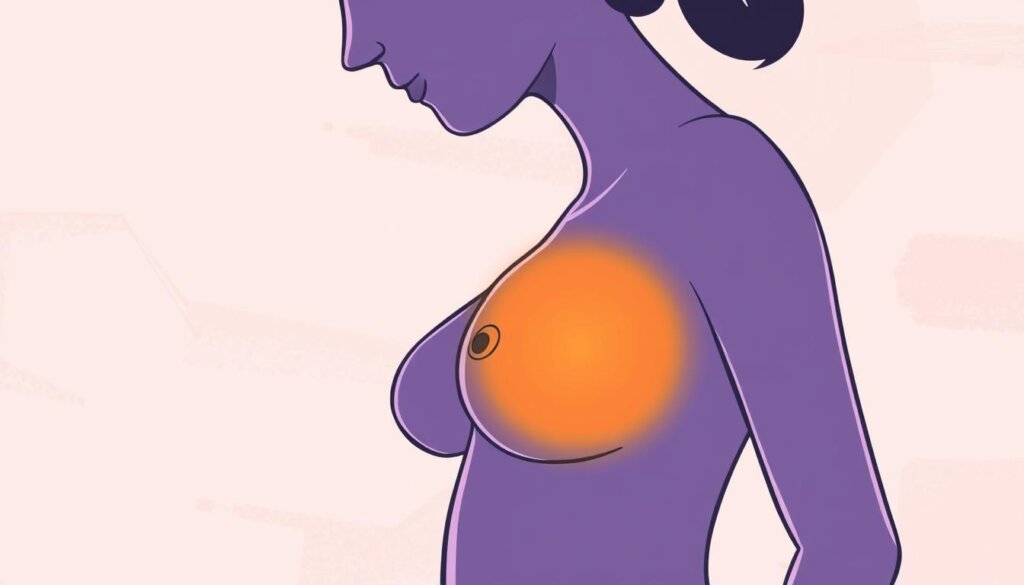
Lymph Node Neoplasm Symptoms
Lymph node neoplasms, like lymphoma, can show many symptoms. These signs might mean there are cancerous growths in the lymphatic system. Symptoms include swollen lymph nodes, fever, weight loss, and feeling very tired.
Other signs are a swollen abdomen, chest pain, and shortness of breath. You might also get severe infections or bruise easily. B symptoms include fever without infection, night sweats, and swollen lymph nodes.
Lymphoma can affect different parts of the body, causing various symptoms. You might feel lumps under the skin, especially in the neck, groin, or underarm. These lumps are usually not painful.
Abdominal lymphomas can cause swelling or pain. This is because of enlarged lymph nodes or organs like the spleen or liver. It can also lead to appetite loss and feeling full too soon.
Lymphomas in the chest can press against the trachea. This causes coughing, breathing difficulties, or chest discomfort. It can also lead to swelling and breathing problems (SVC syndrome).
Lymphomas affecting the brain can cause headaches and cognitive issues. You might also experience weakness, personality changes, seizures, facial numbness, double vision, and speech difficulties. Skin lymphomas are noticeable as itchy, red, or purple lumps under the skin.
Non-Hodgkin lymphoma is more common than Hodgkin lymphoma. The risk of non-Hodgkin lymphoma increases with age, especially over 65. Hodgkin lymphoma peaks in young adults aged 20 to 40 and older individuals over 55.
Lymphoma is more common in people with an impaired immune system. This includes those with immune diseases or immune suppressive drugs. Infections like Epstein-Barr virus and helicobacter pylori can also increase the risk of lymphoma.
If you think you might have a lymph node neoplasm, seek medical attention. Cancer in lymph nodes may need more tests to find out how far it has spread.
Early detection and management of lymph node neoplasms can greatly improve your chances of successful treatment and recovery. Don’t hesitate to consult with a healthcare professional if you have any concerns or experience any of the symptoms associated with lymph node neoplasms.
Skin Neoplasm Symptoms
Skin neoplasms, like skin cancer, show many symptoms. Basal cell carcinoma is the most common, making up 60% of all malignant skin neoplasms. Squamous cell carcinoma makes up 20%. But, malignant melanoma is rare, making up only 1% of skin cancers. Yet, it causes over 60% of skin cancer deaths.
Skin neoplasms can look like lesions, open sores, itchy or painful rashes, bumps, and changes in moles that may bleed. Actinic keratosis or solar keratosis can turn into squamous cell carcinoma if not treated. Bowen’s disease, a precancerous condition, has less than a 10% chance of becoming cancer. Early treatment is key, as nearly all skin cancers can be cured.
Squamous cell carcinoma starts in squamous cells, which are in the middle and outer layers of the skin. It’s often caused by too much UV radiation from the sun, tanning beds, or lamps. People with Black or brown skin are more likely to get it in areas not exposed to the sun, like the genitals.
Being at risk includes having skin that sunburns easily, spending too much time in the sun, and using tanning beds. A history of sunburns or precancerous skin lesions, a history of skin cancer, and a weakened immune system also increase risk. Untreated squamous cell carcinoma can cause tissue destruction, spread to lymph nodes or other organs, and in rare cases, be fatal.
To lower the risk of squamous cell carcinoma, stay out of the sun during peak hours, wear sunscreen, and use protective clothing. Avoid tanning beds and check your skin regularly for any changes. Mayo Clinic is among the top Cancer hospitals in the nation for 2024-2025 by U.S. News & World Report.
Skin neoplasms can be benign or malignant. Benign ones are noncancerous and don’t spread. Malignant ones are cancerous and can spread to other organs. Common benign skin neoplasms include skin tags, cherry angioma, lipoma, and seborrheic keratosis. Malignant ones include basal cell carcinoma, squamous cell carcinoma, melanoma, and lymphoma of the skin.
Precancerous neoplasms, like actinic keratosis and squamous cell carcinoma in situ, can turn into cancer if not treated. Neoplasms of uncertain behavior need more testing, like a biopsy, to see if they are malignant or benign. When doing a skin self-exam, look for the ABCDE signs of melanoma: asymmetry, uneven borders, different colors, diameter larger than ¼ inch, and evolving characteristics.
Risk factors for skin cancer include fair skin, family history, using tanning beds, many moles, sun-sensitive skin, and history of sunburns. Skin biopsies for diagnosing include shave biopsy, punch biopsy, and excisional biopsy. Early detection through regular skin self-exams is key for successful treatment.
Diagnosing Neoplasms
Doctors use many steps to find out if you have a neoplasm. They start by looking at your health history and doing a physical check-up. They might also do blood tests to see how your body is working.
Imaging tests like CT scans and MRI scans are also important. These help doctors see inside your body to find any problems.
If doctors find a mass, they might take a biopsy. This means they take a small piece of tissue to check under a microscope. The results help them decide how to treat you.
Finding problems early and knowing what they are is key. Doctors use many tools to understand your health and plan your treatment.
Every person’s fight with a neoplasm is different. It’s important to work with your doctors to get the right diagnosis and treatment.
Diagnostic Technique | Purpose |
|---|---|
Blood Tests | Provide information about organ functions, detect blood cancers, and monitor health during/after treatment. |
Imaging Tests | Generate detailed visualizations of the body’s internal structures to identify abnormalities. |
Biopsy | Confirm cancer diagnosis by examining abnormal tissue samples under a microscope. |
Pathology Report | Provides critical insights to guide treatment decisions |
Tests like blood work, scans, and biopsies help doctors find and treat neoplasms. Working with your healthcare team is important for managing your condition well.
“Early detection and accurate diagnosis are essential for the effective management of neoplastic diseases.”
Treatment Options for Neoplastic Disease
Treating neoplasms or cancerous tumors needs a plan made just for you. This plan depends on the tumor’s size, where it is, and how bad it is. Treatments include surgery, ablation, embolization, and more. Each plan is made to fit the patient’s needs and the tumor’s specifics.
Approaches to Managing Neoplasms
Surgery is often the first step in treating many cancers. It aims to remove the tumor completely. After surgery, treatments like chemotherapy or radiation might be used. These help kill any cancer cells left behind and lower the chance of it coming back.
Before surgery, some treatments are given to make it more effective. This is called neoadjuvant therapy. For those with advanced cancer, palliative care helps manage pain and symptoms. This improves their quality of life.
Cancer treatments can have side effects. These vary based on the treatment. Chemotherapy uses drugs to kill cancer cells. It’s often used with surgery or radiation.
Radiation therapy uses beams to destroy cancer cells. Immunotherapy uses the body’s immune system to fight cancer.
Hormone therapy stops hormone-sensitive cancers from growing. Targeted therapy attacks specific changes in cancer cells. New treatments like cryoablation and clinical trials are also available.
The right treatment depends on many things. These include the cancer type and stage, the patient’s health, and their wishes. Thanks to cancer research, more treatment options are available.
“Cancer treatment is a rapidly evolving field, with ongoing research and development of new therapies that offer hope and improved outcomes for patients.”
Conclusion
Neoplasms, or abnormal tissue growths, can be either benign or malignant. It’s important to know their causes, symptoms, and how to diagnose them for early treatment. The main goal is to cure cancer patients or extend their lives while keeping their quality of life good.
Early detection programs are key. They help find cases early when treatment works best.
The exact causes of neoplastic disease are still being researched. But, common risk factors include genetics, lifestyle, and toxins or radiation exposure. Tumor immunology has grown, aiming to fight cancer with immunotherapy. Studies and trials are ongoing to improve this field for human cancers.
Quick medical care and a treatment plan tailored to you can greatly improve your chances. This is especially true for neoplastic diseases.
In short, early detection, prevention, and better treatments are key in fighting neoplasms. By understanding these growths, you can take steps to keep yourself healthy. And, seek medical help if you need it.
FAQ
What is a neoplasm?
A neoplasm is an abnormal growth of cells. It forms a mass of tissue, called a tumor. These growths can be either benign (noncancerous) or malignant (cancerous).
What are the different types of neoplasms?
Neoplasms are divided into benign and malignant types. Benign tumors grow slowly and don’t spread. Malignant tumors grow fast and can spread to other tissues and organs.
What causes neoplastic diseases?
The exact causes of tumor growth are still being researched. But, cancerous tumor growth is often triggered by DNA mutations in cells. These mutations can come from genetics, age, hormones, lifestyle, and toxins or radiation.
What are the common symptoms of neoplastic diseases?
Symptoms vary based on the tumor’s location. Common symptoms include anemia, shortness of breath, and abdominal pain. Other symptoms are persistent fatigue, loss of appetite, and fever.
Other signs include bloody stools, lesions, and skin masses.
What are the symptoms of breast neoplasms?
The main symptom of breast cancer is a mass or lump in the breast. Symptoms also include tenderness, pain, and swelling. Redness or irritation, changes in breast shape, and nipple discharge are other signs.
What are the symptoms of lymph node neoplasms?
A tumor in the lymph nodes causes swelling or a mass. Symptoms of lymphoma include swelling in the neck, armpits, or groin. Weight loss, fever, fatigue, and night sweats are also symptoms.
What are the symptoms of skin neoplasms?
Neoplasms can cause skin cancer. Symptoms include lesions, open sores, and itchy or painful rashes. Bumps and changes in moles that may bleed are also signs.
How are neoplasms diagnosed?
Diagnosing neoplastic diseases involves confirming the presence of a neoplasm. Doctors will review medical history and conduct blood tests. A biopsy of visible masses may also be done.
Tests like CT scans, MRI scans, and PET scans are used. Mammograms, ultrasounds, X-rays, and endoscopies may also be needed.
What are the treatment options for neoplastic diseases?
Treatment depends on the tumor’s size, location, and malignancy. Options include monitoring, surgical removal, and ablation. Embolization, chemotherapy, radiation therapy, hormonal therapy, and immunotherapy are also options.
The treatment plan is tailored to the patient’s needs and the neoplasm’s characteristics.
